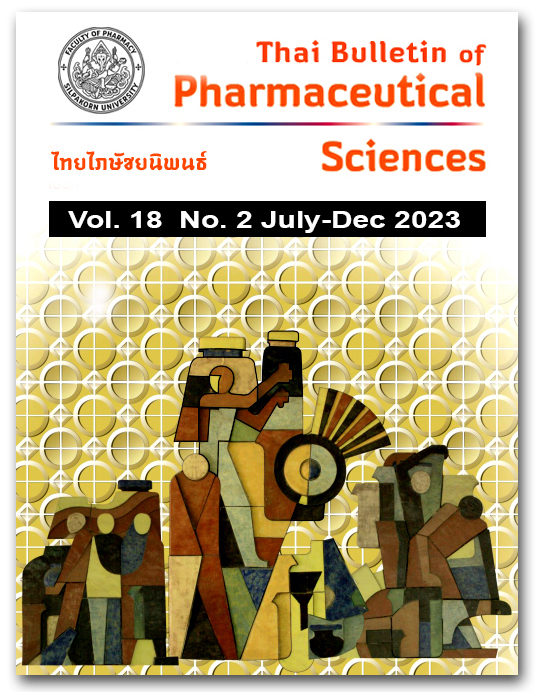EVALUATION ON IMPLEMENTING THE PATIENT INFORMATION LEAFLET OF THE DIVISION OF INNOVATIVE HEALTH PRODUCTS AND SERVICES, THAI FOOD AND DRUG ADMINISTRATION
DOI:
https://doi.org/10.69598/tbps.18.2.93-107Keywords:
patient information leaflet, food and drug administration, CIPP modelAbstract
The purposes of this research were to evaluate the problems arising from implementing the patient information leaflet (PIL) of the Division of Innovative Health Products and Services, Thai Food and Drug Administration (Thai FDA) by the CIPP model (context, input, process and product evaluation) and to establish guidelines for implementing the PIL. Research was completed using a mixed quantitative method to collect data in October 2021 via an email link to a Google form questionnaire, which was sent to 150 subjects who worked in the areas of management, performance or who were marketing authorization holders. The data were analyzed by descriptive statistics such as mean and standard deviation. Quantitative data acted as a baseline to establish guidelines for implementing the PIL which used qualitative data. During December 2021, qualitative data were collected through in-depth interviews and focus groups, totaling 18 subjects. The data were analyzed by thematic analysis. The subjects completed and returned 135 questionnaires (90%). The main problem was that the cost of implementing the PIL user testing was too high. (Mean of the opinion’s score: 3.54±0.90; full score: 5.00). The second problem was that there were insufficient numbers of Thai FDA staff. (Mean of the opinion’s score: 3.10±1.24). For the qualitative research, the main problem aligned with the results of the quantitative research. Adding to the second problem is that there is a lack of personnel who have knowledge about the PIL. It is recommended that the Thai FDA increase the number of knowledgeable government officers and marketing authorization holders to mitigate these concerns. Thus, the Division of Innovative Health Products and Services should apply these findings to further development.
References
Ministerial Regulations: Drugs Act B.E. 2510. [Internet]. [cited 31 March 2020]. Available from: http://www.fda.moph.go.th/sites/drug/Shared%20Documents/Law02-Ministerial-regulations/ministerial-18.pdf. (in thai).
Food and Drug Administration. Asean Harmonized Products. Asean Common Technical Requirements and Asean Common Technical Dossier for pharmaceutical registration of Asean: Nonthaburi; 2005. (in thai).
Food and Drug Administration. Guideline of Patient Information Leaflet: Nonthaburi; 2006. (in thai).
Leelakranon S. Knowledge, Understanding and Public Opinion on Patient Information Leaflet of Aspirin in Nong Hong, Buriram. Self Study, Master's Degree. Department of Community Pharmacy, Naresuan University; 2010. (in thai).
Food and Drug Administration. Guideline for leaflet development FDA announcement. [Internet]. 2013. Available from: http://www.rapat.or.th/images/column_1344932177/ya-20131219-03.pdf.
Food and Drug Administration: Division of Innovative Health Products and Services. Guideline for Leaflet Development for Drug research and Innovation. [Internet]. 2019 [cited 6 June 2022]. Available from: https://www.fda.moph.go.th/sites/oss/Shared%20Documents/SmPC-PIL_HPEP%20guideline_updated%20May2019.pdf.
CIPP Evaluation Model Checklist. [Internet]. 2007 [cited 16 November 2022].
European Medicines Agency.Quality review of documents human product-information annotated template. [Internet]. 2021 [cited 10 May 2022]. Available from: https://www.ema.europa.eu/en/documents/template-form/qrd-product-information-annotated-template-english-version-102-rev1_en.pdf.
Fucharoen S. Common bias in research. J Med Tech Phy Ther. 2014;26(1):1-4.
Cambridge Regulatory Services. User testing of patient leaflet. [Internet]. [cited 8 May 2022]. Available from: https://cambreg.co.uk/regulatory-services/registration/user-testing-of-patient-leaflet/.
Dipharm. The practical application of readability user tests in national and international marketing authorisation procedures. [Internet]. [cited 8 May 2022]. Available from: https://www.diapharm.com/en/news/the-practical-application-of-readability-user-tests-in-national-and-international-marketing-authorisation-procedures/.
Pharmafile. Readability User Testing [Internet]. [cited 8 May 2022]. Available from: https://www.pharmafile.ie/our-services/regulatory-affairs-management/readability-user-testing/.
Pharma EU s.r.o. Readability User Testing of Patient Information Leaflets (PILs) [Internet]. [cited 8 May 2022]. Available from: https://www.pharma-eu.com/pil-readability-user-tests.htm.
Martifarm. Medicinal regulations are rigid and complex, and it is often a challenge to fulfill them all on time. [Internet]. [cited 8 May 2022]. Available from: https://martifarm.com/rutpil-bridging-report/?msclkid=e8977cddcec511ec9c4f7564182cbc7f.
Panyowat D, Prommarat P. Training strategies affecting performance efficiency among operation officers in Bank for Agriculture and Agricultural Cooperatives, Roi Et province. J Roi Et Rajabhat Univ. 2019;13(3):55-67.
Pattanasumpan A. The developing organizational for efficiency according to McKinsey’s 7s framework. a case study of Wellgrow Industrial Estate Bang Pakong district. Rajabhat Ranbhai Barni Res J. 2021;16(1):5-14.
Health Intervention and Technology Assessment Program Foundation. Project of developing the system of structure of protection for healthcare products in Thailand [Internet]. 2016. Available from: https://www.hitap.net/documents/166401.
European Medicines Agency. Science Medicines Health. Medicines [Internet]. [cited 10 May 2022]. Available from: https://www.ema.europa.eu/en/medicines.
U.S. Food and Drug Administration. Drug@FDA: FDA-Approved Drug [Internet]. [cited 10 May 2022]. Available from: https://www.accessdata.fda.gov/scripts/cder/daf/.
Australian Government. Department of Health. Therapeutic Goods Administration. Consumer Medicines Information (CMI). [Internet]. 2020 [cited 10 May 2022]. Available from: https://www.tga.gov.au/consumer-medicines-information-cmi.
Azad A, Laidlaw DAH, Orlans HO. Using QR smartphone technology to improve patient communication and information distribution. Eye (Lond). 2022;36(6):1321-1322.
Svensk J, McIntyre SE. Using QR code technology to reduce self-administered medication errors. J Pharm Pract. 2021;34(4):587-91.
Stufflebeam DL. The CIPP Model for Evaluation. The International Handbook of Education. Boton; Kluwer.2007.
Downloads
Published
How to Cite
Issue
Section
License
All articles published and information contained in this journal such as text, graphics, logos and images is copyrighted by and proprietary to the Thai Bulletin of Pharmaceutical Sciences, and may not be reproduced in whole or in part by persons, organizations, or corporations other than the Thai Bulletin of Pharmaceutical Sciences and the authors without prior written permission.



